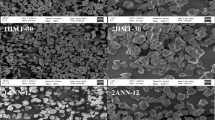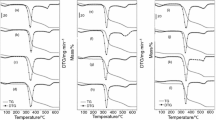Abstract
In this study, organic taro starch was submitted to dual modification: the first modification was by heat-moisture treatment (HMT), which totalled nine treatments, combining three moisture levels (13, 19 and 25%), three time intervals (45, 60 and 75 min) and a temperature of 120 °C, and the second modification was by ultrasound (US), which was applied for 30 min at 60% amplitude (frequency of 20 kHz) for all the samples. The morphology of the granules did not show major changes; the relative crystallinity decreased after HMT and increased after the second treatment by US, varying between 26.9 and 32.7%. The Rapid Visco Analyser (RVA) profile showed a decrease in all parameters, except for the pasting temperature. The gelatinisation showed an increase in enthalpy change for all the HMT-modified samples, up to 14.8 J g−1. Moreover, an extension of the gelatinisation range also occurred, suggesting a higher stability in relation to heating; the values ranged from 9.3 (native sample) to 16.7 J g−1 for the HMT-modified sample. The dual-modified samples resulted in a lower gelatinisation temperature range and a decrease in enthalpy change; 4.1 J g−1 was the lowest value. The chemometric approach resulted in a better understanding of the behaviour of the samples modified by dual modification.






Similar content being viewed by others
References
Bemiller JN, Hubber KC. Physical modification of food starch functionalities. Ann Rev Food Sci Technol. 2015;6:19–69.
Du S, Bartels J, Reinders M, Sen S. Organic consumption behavior: a social identification perspective. Food Qual Prefer. 2017;62:190–8.
Arns B, Paraginski RT, Bartz J, Schavion RA, Elias MC, Zavareze ER, Dias ARG. The effects of heat moisture treatment of rice grains before parboiling on viscosity profile and physicochemical properties. Int J Food Sci Technol. 2014;49:1939–45.
Lee CJ, Kim Y, Choi SJ, Moon TW. Slowly digestible starch from heat-moisture treated waxy potato starch: preparation, structural characteristics, and glucose response in mice. Food Chem. 2012;133:1222–9.
Patist A, Bates D. Ultrasonic innovations in the food industry: from the laboratory to commercial production. Innov Food Sci Emerg Technol. 2008;9:147–54.
Adewuyi YG. Sonochemistry in environmental remediation: combinative and hybrid sonophotochemical oxidation processes for the treatment of pollutants in water. Environ Sci Technol. 2005;39:3409–20.
Eleazu CO, Ogbonnaya C, Okafor PN, Ifeoma I. Biochemical basis of the use of cocoyam (Colocassia esculenta L.) in the dietary management of diabetes and its complications in streptozotocin induced diabetes in rats. Asian Pac J Trop Dis. 2014;4:S705–11.
Ito VC, Schnitzler E, Demiate IM, Eusébio MES, Lacerda LG, Castro RAE. Physicochemical, thermal, crystallographic, and morphological properties of biodynamic black rice starch, and of residual fractions from aqueous extraction. Starch-Stärke. 2018;70(11–12):1700348.
Bet CD, Oliveira CS, Colman TAD, Marinho MT, Lacerda LG, Ramos AP, Schnitzler E. Organic amaranth starch: a study of its technological properties after heat-moisture treatment. Food Chem. 2018;264:435–42.
Zhu J, Li L, Chen L, Li W. Study on supramolecular structural changes of ultrasonic treated potato starch granules. Food Hydrocol. 2012;29:116–22.
Nara S, Komiya T. Studies on the relationship between water-saturated state and crystallinity by the diffraction method for moistened potato starch. Starch/Starke. 1983;35:407–10.
Kubiaki FT, Figueroa AM, Oliveira CS, Demiate IM, Schnitzler E, Lacerda LG. Effect of acid-alcoholic treatment on the thermal, structural and pasting characteristics of European chestnut (Castanea sativa, Mill) starch. J Therm Anal Calorim. 2018;131:587–94.
Ito VC, Alberti A, Avila S, Spoto M, Nogueira A, Wosiacki G. Effects of gamma radiation on the phenolic compounds and in vitro antioxidant activity of apple pomace flour during storage using multivariate statistical techniques. Innov Food Sci Emerg Technol. 2016;33:251–9.
Hoover R. The impact of heat-moisture treatment on molecular structures and properties of starches isolated from different botanical sources. Crit Rev Food Sci Nutr. 2010;50:37–41.
Jiranuntakul W, Puttanlek C, Rungsardthong V, Puncha-Arnon S, Uttapap D. Microstructural and physicochemical properties of heat-moisture treated waxy and normal starches. J Food Eng. 2011;104:246–58.
Zhu F. Impact of ultrasound on structure, physicochemical properties, modifications, and applications of starch. Trends Food Sci Technol. 2015;43:1–17.
Vermeylen R, Goderis B, Delcour JA. An X-ray study of hydrothermal treated potato starch. Carbohydr Polym. 2006;64:364–75.
Zavareze ER, Storck CR, Castro AS, Schirmer MA, Dias AR. Effect of heat-moisture treatment on rice starch of varying amylose content. Food Chem. 2010;121:358–65.
Silva PCF, Cruz CAR, Esquivel GC, Carter EJV, Perez LAB, Ramirez JA. In vitro digestibility of ultrasound-treated corn starch. Starch/Stärke. 2017;69:1–9.
Aboubakar NYN, Scher J, Mbofung CMF. Physicochemical, thermal properties and microstructure of six varieties of taro (Colocasia esculenta (L.) Schott) flours and starches. J Food Eng. 2008;86:294–305.
Jiranuntakul W, Puttanlek C, Rungsardthong V, Puncha-Arnon S, Uttapap D. Microstructural and physicochemical properties of heat-moisture treated waxy and normal starches. J Food Eng. 2011;104:246–58.
Garcia RC, Perez LAB, Aguirre-Cruz A, Hernandez JT, Cruz AC, Ramirez AJ. Effect of ultrasonic treatment on the morphological, physicochemical, functional, and rheological properties of starches with different granule size. Starch/Stärke. 2016;68:972–9.
Jambrak AR, Herceg Z, Subaric D, Babic J, Brncic M, Brncic SR. Ultrasound effect on physical properties of corn starch. Carbohydr Polym. 2010;79:91–100.
Bai W, Hébraud P, Ashokkumar M, Hemar Y. Investigation on the pitting of potato starch granules during high frequency ultrasound treatment. Ultrason Sonochem. 2017;35:547–55.
Wang S, Li C, Copeland L, Niu Q, Wang S. Starch retrogradation: a comprehensive review. Comp Rev Food Sci Food Saf. 2015;14:568–85.
Zavareze ER, Dias ARG. Impact of heat-moisture treatment and annealing in starches: a review. Carbohydr Polym. 2011;83:317–28.
Luo Z, Fu X, He X, Luo F, Gao Q, Yu S. Effect of ultrasonic treatment on the physicochemical properties of maize starches differing in amylose content. Starch/Stärke. 2008;60:646–53.
Pepe LS, Moraes J, Albano KM, Telis VRN, Franco CML. Effect of heat-moisture treatment on the structural, physicochemical, and rheological characteristics of arrowroot starch. Food Sci Technol Int. 2015;22:256–65.
Pinto VZ, Vanier NL, Deon VG, Moomand K, Halal SLME, Zavareze ER. Effects of single and dual physical modifications on pinhão starch. Food Chem. 2015;187:98–105.
Molavi H, Razavi SMA, Farhoosh R. Impact of hydrothermal modifications on the physicochemical, morphology, crystallinity, pasting and thermal properties of acorn. Food Chem. 2018;245:385–93.
Flores-Silva PC, Roldan-Cruz CS, Chavez-Esquivel G, Vernon-Carter EJ, Bello-Perz LA, Alvarez-Ramirez J. In vitro digestibility of ultrasound-treated corn starch. Starch/Stärke. 2017;8:1–9.
Acknowledgements
The authors are deeply grateful to the Coordination for the Improvement of Higher Education Personnel (CAPES) for scholarship and to C-LABMU-UEPG for the infrastructure.
Author information
Authors and Affiliations
Corresponding author
Additional information
Publisher's Note
Springer Nature remains neutral with regard to jurisdictional claims in published maps and institutional affiliations.
Rights and permissions
About this article
Cite this article
Thomaz, L., Ito, V.C., Malucelli, L.C. et al. Effects of dual modification on thermal, structural and pasting properties of taro (Colocasia esculenta L.) starch. J Therm Anal Calorim 139, 3123–3132 (2020). https://doi.org/10.1007/s10973-019-08728-1
Received:
Accepted:
Published:
Issue Date:
DOI: https://doi.org/10.1007/s10973-019-08728-1




